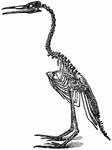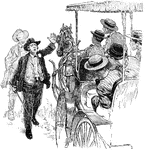
Hyoid Series of Bones in a Horse
The hyoid series is composed of five distinct pieces- a body, or hyoid bone proper, two cornua or horns…

Carpus of a Horse
Front aspect of the right carpus of a horse. Labels: 1, cuneiform; 2, lunar; 3, scaphoid; 4, trapezium;…
Horse Leg
External view of bones of right carpus, metacarpus, and digit of a horse. 1, distal end of radius; 2,…

Evolution of Horse Foot
Generic development of the horse's foot. A, Foot of Eohippus; B, That of Orohippus; C, That of Hipparion;…

Phalanges of a Horse
Posterior view of phalanges of a horse disarticulated. Labels: a, os suffraginis; b, os coronae; C,…

Pelvis of a Horse
Left posterolateral view of a horse's pelvis. 1, anterior iliac spine; 2, Posterior iliac spine. The…
Femur of a Horse
Posterior view of a left femur of a horse. Labels: 1, head; 2, trochanter major; 3, trochanter minor;…

Tarsus of a Horse
Bones of left tarsus of a horse, seen from in front and outside. Labels: 1, calcaneum; 2, astragalus;…
Horse Leg
External view of bones of left tarsus, metatarsus, and digit of a horse. Labels: 1, distal end of tibia;…
Metatarsus of a Horse
Posterior view of left metatarsus of a horse. 1, Large metatarsal bone; 2, Internal small metatarsal…
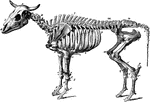
Ox Skeleton
The skeleton of an ox. Axial Skeleton. The skull. Cranial Bones- occipital, 1: b, parietal, 2; a, frontal,…

Skeleton of a Hog
Skeleton of the hog. Axial skeleton. The skull. Cranial bones- a, occipital, 1; b, parietal, 2; d, frontal,…
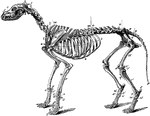
Skeleton of a Dog
The skeleton of the dog. Axial skeleton. The skull. Cranial bones- a, occipital, 1; b, parietal, 2;…
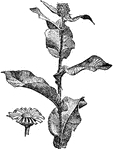
Elecampane
Elecampane, also called Horse-heal (Inula helenium) or Marchalan (in Welsh), is a perennial composite…

Seahorse
Seahorses are a genus (Hippocampus) of fish belonging to the family Syngnathidae, which also includes…

Seal of Minnesota
The Great Seal of the State of Minnesota. The seal depicts a farmer plowing as a Native American rides…
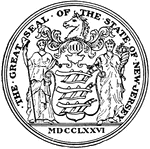
Seal of New Jersey
The Great Seal of the State of New Jersey. The seal features Liberty and Ceres holding a shield with…
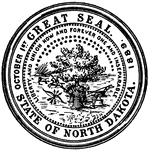
Seal of North Dakota
The Great Seal of the State of North Dakota. The seal depicts a tree, wheat, a plow, and a Native American…

Archaeopteryx Fossil
An illustration of the skeletal fossil of Archaeopteryx, the earliest and most primitive bird known.…
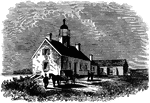
Lighthouse on Horse Island
The Sackett's Harbor lighthouse was erected on Horse Island during the War of 1812.
Archaeopteryx Skeleton
An illustration of an Ichthyosaurus skeleton. Ichthyosaurus is an extinct genus of ichthyosaur from…

Jellyfish
An illustration of a small jellyfish. Jellyfish are free-swimming members of the phylum Cnidaria. ellyfish…
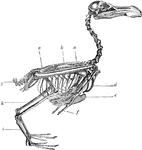
Skeleton of a Bird
The skeleton of a bird. Labels: a, radius and ulna; b, dorsal vertebrae; c, sacrum and pelvis; g, ploughshare…
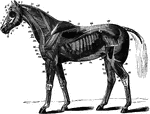
Superficial Muscles of the Horse
The superficial muscles of the horse with the panniculus and tunica abdominalis removed. Labels: 1,…

Muscles of the External Ear of a Horse
Muscles of the external ear- posterior view. Labels: a, inferior and b, superior layer of the scuto-auricularis…
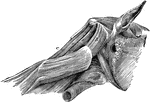
Neck Muscles of a Horse
The neck muscles of a horse-lateral view. Labels: a, oblique capitis posticus; b, obliquus capitis anticus;…
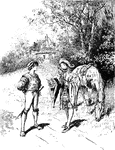
Two Men Talking
Two men in renaissance clothing having a conversation on the side of the road. The man to the left is…
Diplodocus
An illustration of a Diplodocus skeleton and the caudal vertebrae (A and B). Diplodocus is a genus of…

Dodo Skeleton
Illustration of a dodo bird skeleton. The dodo (Raphus cucullatus) was a flightless bird endemic to…
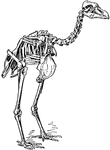
Pezophaps Solitarius (Skeleton)
An illustration of the skeleton of a pezophaps solitarius, part of the dodo family.
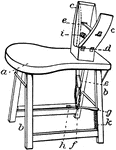
Sewing Horse
"Sewing-horse. In saddlery, a sewing-clamp with its supports. a, seat; b, legs; c, c', clamping-jaws,…
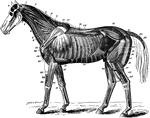
Neck Muscles of the Horse
The deep muscles of the horse. Labels: 1, temporalis; 1', stylo-maxillaris; 2, rectus capitis anticus…
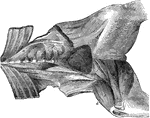
Muscles From the Femoral Region of the Horse
Muscles of the sublumbar and internal deep femoral regions-seen from below. Labels: a, quadratus lumborum;…
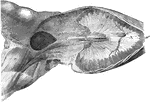
Muscles From the Femoral Region of the Horse
The diaphragm, and superficial muscles of the internal femoral region-viewed from below. A, the diaphragm;…
Horse Leg Muscles
Muscles of the anterior limb-external view. Labels: a, antea-spinatus; b, postea-spinatus; c, teres…
Horse Leg Muscles
Muscles of the anterior limb-internal view. Labels: a, subscapularis; b, teres internus; c, coracohumeralis;…
Horse Leg Muscles
External view of the muscles of the anterior limb-showing the deeper ones of the upper region. Labels:…
Horse Leg Muscles
Internal view of the deep muscles of the anterior limb. Labels: a, caput parvum of triceps extensor…
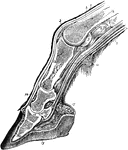
Section Through the Horse Leg and Hoof
Longitudinal section through the digit of a horse. Labels: 1, skin; 2, extensor pedis tendon; 3, synovial…
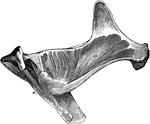
Muscles from Gluteal Region of a Horse
Deep-seated muscles of the gluteal region. Labels: a, deep anterior portion of gluteus maximus; b, gluteus…
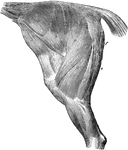
Thigh and Haunch Muscles of a Horse
The muscles of the thigh and haunch- left side; the external fascia being removed. Labels: a, tensor…
Horse Leg Muscles
Anterior tibial group of muscles of the right limb, seen from before and the outside. Labels: a, flexor…

Tendons and Ligaments of Ox Leg
Tendons and ligaments of the left anterior extremity of ox, viewed from external side. Labels: a, flexor…
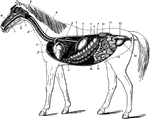
Digestive Apparatus of the Horse
The digestive apparatus of the horse. Labels: a, mouth; 2, pharynx; 3, esophagus; 4, diaphragm; 5, spleen;…

Muscles of the Maxillary Space of a Horse
Right infero-lateral view of the muscles of the maxillary space, the ramus and hyoid cornu are cut away.…

Parotid and Molar Glands of a Horse
Parotid and molar glands of the left side. Labels: a, parotid gland; b, Steno's duct; c, superior molar…

Horse Head
Right infero-lateral view of the head; the maxillary ramus, cheek, parotid gland, and upper lip being…
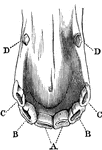
Incisor and Canine Horse Teeth
Incisor and canine teeth of a horse. A, front, B, lateral, and C, corner incisor; D, canine teeth.

Horse Incisor Tooth
Incisor tooth of a horse-posterior view. Labels: a, outer layer of enamel; b, inner layer of enamel…
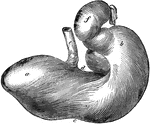
Horse Stomach
Posterior view of the stomach of a horse. Labels: a, left cul-de-sac; b, right cul-de-sac; c, greater…

Horse Stomach
Internal aspect of a horse stomach, opened from below. Labels: a, cuticular mucous membrane; b, villous…
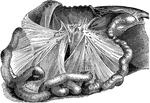
Mesenteries of a Horse
The two mesenteries; the great colon being removed. Labels: a, anterior mesentery; b, mesenteric glands;…
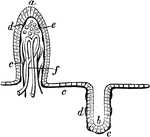
Mucous Membrane
Section of mucous membrane of the small intestine. One the left a villus is seen in seen in section.…

Caecum and Colon of Horse
Caecum and great colon of a horse. Labels: a, caecum; b, c, its muscular bands; d, termination of the…
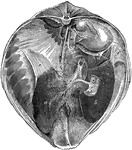
Liver and Diaphragm of a Horse
Posterior view of the liver and diaphragm in situ. Labels: a, left lobe; b, right lobe; c, quadrate…
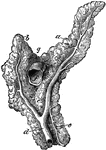
Pancreas of a Horse
Anterior view of the pancreas. Labels: a, left branch; b, right branch; c, inferior branch; d, duct…

Spleen of a Horse
Internal aspect of the spleen. Labels: a, superior extremity, or base; b, inferior extremity; c, internal…
